|
|
General: ¿PORQUE NAPOLEON ERA FRANC MASON? NEXO CODIGO DA VINCI/ISHTAR GATE/ORION
Elegir otro panel de mensajes |
|
|
¿PORQUE NAPOLEON ERA FRANC MASON? MENSAJES SUBLIMINALES DE YHWH TODOPODEROSO
A pesar de los errores de los lideres politicos, YHWH, LOS USA PARA DARNOS MENSAJES SUBLIMINALES CON REFERENCIA AL SANTO GRIAL. ASI PASO CON ADOLF HITLER, FIDEL CASTRO, CHE GUEVARA, CHAVEZ, JUAN DOMINGO PERON, JOHN KENNEDY, ETC,ETC. NAPOLEON TIENE UN NEXO CON EL LEON, OSEA UN NEXO CON LEONARDO DAVINCI, EN EL MARCO A FRANCIA / ANK / LIBERTAD. ESE ES EL ORIGEN DEL PORQUE NAPOLEON TUVO RELACION CON EL COMPLEJO GIZE/ ORION / ISHTAR GATE. SABEMOS QUE LA ESFINGE DE GIZE, ESTA DISEÑADA EN FUNCION A AL COMIENZO DE LA ERA DE ACUARIO (PATRON DEL CALENDARIO DE NOE) EN funcion a la PRECESION DE LOS EQUINOCCIOS.
En el marco a APOCALIPSIS 12 E INCLUSO APOCALIPSIS 4:7, en funcion al movimiento de la PRECESION DEL PLANETA TIERRA EN SU MOVIMIENTO DE 25920 AÑOS, la tierra hace aproximadamente 12960 AÑOS estaba en LA ERA DE LEO y es en ese MARCO EL DISEÑO DEL COMPLEJO GIZE. LA ESFINGE (HOMBRE-LEON) ESTA DISEÑADA EN FUNCION A LA LINEA LEO-ACUARIO O ACUARIO-LEO. EN DICHA ERA, EL 21/22 DE MARZO VA A ESTAR EN ACUARIO Y EL 21/22 DE SEPTIEMBRE, OSEA EN LOS EQUINOCCIOS VA A ESTAR EN LEO. NO FUE CASUALIDAD QUE NAPOLEON VISITO EGIPTO. TODOS SON MENSAJES SUBLIMINALES DE YHWH TODOPODEROSO. CONCRETAMENTE GIZE ESTA DISEÑADO EN FUNCION A LA ERA DE ACUARIO. LEONARDO DA VINCI O EL CODIGO DA VINCI ES SINONIMO DE GIZE.
freemasonry.bcy.ca/aqc/napoleon.html
"The evidence in favor of a Masonic initiation previous to Napoleon's ... THE
question whether Buonaparte was a Freemason or not has never been decided.
... "You ask me Sir, why it was that in my work on Free Masonry I did not say a
word ...
www.agustincelis.com/id65.htm
Para los historiadores que se afilian a la leyenda negra de la masonería como
sociedad secreta conspiradora, la historia de Napoleón Bonaparte, Le Petit ...
espaciomasonico.bligoo.com.ve/fue-francmason-napoleon
27 Feb 2014 ... Traemos hoy a Memoria Masónica un artículo publicado recientemente por Guy
... ¿Fue Napoleón Bonaparte iniciado francmasón?
masonesfamosos.com/masones-por.../2.../23-bonaparte-napoleon
Napoleón Bonaparte ha sido proclamado y considerado Masón, asi como
también lo han sido su padre, hermanos, e incluso los militares tenientes que se
...
https://ar.answers.yahoo.com/question/index?qid...
Napoleón Bonaparte nace el 15 de Agosto de 1769 en Ajaccio, capital de la isla
de Córcega, en ese entonces recientemente anexada a ...
zoevaldes.net/2013/02/.../la-sombra-de-una-duda-era-napoleon-franc-mason/
27 Feb 2013 ... Les recomiendo además la novela de César Vidal, Los Hijos de la Luz (Plaza
Janés, 2005), yo estuve en el jurado que la premió Con el ...
inmf.org/casinfrancmac.htm
En vísperas de la revolución francesa, la masonería reunía adeptos de todas .....
«Franc-Maçonnerie et sociétés secrètes contre Napoléon» (Francmasonería y ...
es.wikipedia.org/wiki/Francmasonería_en_Francia
Después del nacimiento en Inglaterra de la denominada masonería ... favorecido
pero al mismo tiempo utilizado por el Emperador Napoleón I, ... Es un hecho
simbólico que Eugène Pottier, que escribió La Internacional, fue francmasón.
|
|
|
|
|
Arco de Triunfo del Carrusel
De Wikipedia, la enciclopedia libre
El Carrusel del Louvre, también llamado plaza del Carrusel, se encuentra entre el museo del Louvre y el Jardín de las Tullerías en París (Francia).

Arco de triunfo del Carrusel (al fondo se ve el obelisco de la plaza de la Concordia y más al fondo, el Arco de Triunfo).
En ese lugar Napoleón Bonaparte hizo construir un arco de triunfo llamado el Arco de Triunfo del Carrusel, en conmemoración de sus victorias militares. El arco fue construido entre 1806 y 1808 por Pierre-François-Léonard Fontaine y Charles Percier, según el modelo del arco de Constantino en Roma.
Los cuatro caballos originales de la cuadriga de bronce que se halla en lo alto del arco fueron parte del botín de guerra que Napoleón consiguió al abolir la república de Venecia (1797), los cuales se encontraban en la plaza de la catedral de San Marcos, (que fueron traídas de Constantinopla tras el saqueo de la ciudad en 1204 y a su vez son copias de originales griegos de bronce dorado del siglo IV a. C. que venían del Templo del Sol de Corinto).
Los bajorrelieves relatan sus victorias de 1805. Son obra de los escultores Jean-Joseph Espercieux, Pierre Cartellier, Louis Pierre Deseine y Jacques-Philippe Lesueur.
Las cuatro columnas de orden corintio son de mármol rosa, así como el entablamento. Cada una sirve de pedestal a una estatua de un soldado con el típico uniforme del Gran Ejército napoleónico (ver la foto de derecha).

Estatua de soldado napoleónico del Arco de Triunfo del Carrusel.

Una revista militar frente al Arco del Triunfo del Carrusel, con el Palacio de las Tullerias de fondo - 1864.
El carro está escoltado por las alegorías de la Victoria y de la Paz, en oro (esta última es obra de François Joseph Bosio (1768 - 1845)).
Se cree comúnmente que la persona que conduce el carro es el emperador en persona. Sin embargo, no es así. Efectivamente se fabricó una estatua de bronce de Napoleón en triunfo conduciendo el carro de la victoria, y se la colocó en su lugar correspondiente. Pero el emperador rehusó al final ver su efigie en la cumbre de este arco dedicado al gran ejército. Se quitó la estatua en 1812, solamente debido a dificultades técnicas, y el carro se quedó vacío hasta 1828. La citada estatua de Napoleón es de bronce dorado y es obra de François Frédéric Lemot (fue un pedido de Vivant Denon). Se encuentra actualmente en el museo del Louvre, a escasos cincuenta metros de su destino original.
Cuando en 1815 los oponentes de Napoleón ocupan París, desmontan los bajorrelieves, devuelven los caballos a Venecia y destruyen el carro.
Los bajorrelieves se vuelven a montar en 1820 y, ocho años más tarde, el rey Carlos X instala una copia de la cuadriga, conducida por una alegoría de la Restauración (de la monarquía) con la constitución en su mano izquierda.
El frontispicio delantero tiene la siguiente inscripción:
El ejército francés embarcado en Boulogne amenazaba Inglaterra. Una tercera coalición estalla en el continente. Los franceses vuelan del océano al Danubio. Baviera es liberada, el ejército autríaco es preso en Ulm. Napoléon entra en Viena y triunfa en Austerlitz. En menos de cien días la coalición es disuelta.
La parte posterior presenta un aspecto muy semejante, con el siguiente texto en el frontispicio:
A la voz del vencedor de Austerlitz cae el Imperio de Alemania. Empieza la Confederación del Rin. Los reinos de Baviera y Wurtembergo son creados. Venecia es reunida a la corona de hierro. Italia entera adopta las leyes de su liberador.
Gracias a una perfecta alineación, se puede ver desde el arco el jardín de las Tullerías, el obelisco de la plaza de la Concordia, los Campos Elíseos y el Arco del Triunfo. Dando media vuelta, se observa la pirámide del Louvre y el paso a la corte interior del palacio del Louvre.
§Enlaces externos[editar]
http://es.wikipedia.org/wiki/Arco_de_Triunfo_del_Carrusel
|
|
|
|
|
|
| |
|
|
| |

Evening view, courtyard of the Louvre and I.M. Pei pyramid. (Photographer: Benh Lieu Song.)
Louvre {loov'-ruh} — a French palace and the national art museum of France.
Located in Paris, the Louvre is one of the largest palaces in the world and, as a former residence of the kings of France, one of the most illustrious. It exemplifies traditional French architecture since the Renaissance, and it houses a magnificent collection of ancient and Western art.
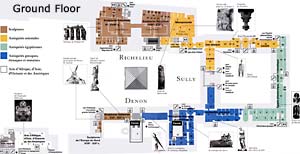 Ground floor diagram, Louvre Museum Ground floor diagram, Louvre MuseumThe Palace
The first Louvre was a fortress built at the beginning of the 13th century by Philip II Augustus to defend the Seine below Paris against the Normans and English. It consisted of a thick cylindrical donjon (dungeon) surrounded by towered walls. This chteau, enlarged and embellished by Charles V in the 14th century, was sacrificed in the 16th century at the end of the reign of Francis I in order to make room for a new Renaissance structure of the same size. Only the west wing and part of the south wing of the projected palace, conceived by the architect Pierre Lescot and decorated with sculptures by Jean Goujon, were finished.
In 1564 Catherine de Médicis had her architect, Philibert Delorme, build a little chteau in a neighboring field to the west called the Tuileries. It was then decided to create a grandiose royal residence by joining the Louvre and the Palais des Tuileries by a series of buildings. The most important is the Grande Galerie built along the Seine in the reign of Henry IV.
| |
|
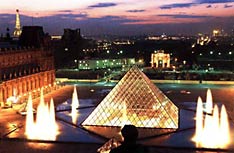
Dusk view of I.M. Pei's pyramid in Louvre courtyard, with Arc du Carrousel in near background. Notice the Place de la Concorde, Arc de Triomphe de l'Etoile, and the Grande Arche de la Défense in far upper right background.
© Jonathan F. Yorck —
All Rights Reserved |
|
| |
In the 17th century Louis XIII and his minister Richelieu extended Lescot's west wing northward by adding the majestically domed Pavillon de l'Horloge (clock pavillion) by Jacques Lemercier and recreating Lescot's building beyond it. Under Louis XIV and his minister Colbert, the Cour Carrée, a great square court, was constructed by Louis Le Vau. The east façade of the east wing was later given a classical colonnade by Le Vau and Claude Perrault. The royal apartments were sumptuously decorated by Charles Le Brun and others, as the Galerie d'Apollon still bears witness. The Louvre was abandoned as a royal residence when Louis XIV moved the court to Versailles in 1682.
After the Revolution of 1789, Napoleon I, later kings, and Napoleon III lived in the Tuileries. The Louvre was used for offices and a museum. Along the Rue de Rivoli, Napoleon I began a wing parallel to that of Henry IV along the Seine. Napoleon III finished the wing, thus closing the great quadrilateral.
A few years later, during the uprising of the Paris Commune in 1871, the Tuileries was burned. Paradoxically, the disappearance of the Tuileries, which had originally brought about the extension of the Louvre, opened the admirable perspective that now stretches from the Arc du Carrousel west through the Tuileries Gardens and the Place de la Concorde to the Place Charles de Gaulle.
| |
|
| |
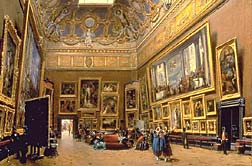
Le Salon Carré, en 1865,
au Musée du Louvre
by Giuseppe Castiglione
Canvas - H 0,69 m ; L 1,03 m
(27"H x 40.5"W) |
| |
In the late 1980s the Louvre embarked upon an aggressive program of renovation and expansion. When the first plans by the Chinese-American architect Ieoh Ming Pei were unveiled in 1984, they included a glass pyramid in the central courtyard that would serve as the museum's main entrance. Despite drawing protests before the fact, since its opening in 1989 the pyramid has proven remarkably effective in accommodating the large numbers of visitors, and has even become a relatively beloved landmark of the city. In November 1993, to mark its 200th anniversary, the museum unveiled the Richelieu wing in the quarters that had been vacated, grudgingly, by the Ministry of Finance in 1989. This expansion, which completed the museum's occupancy of the palace complex, added 230,000 square feet (21,390 sq meters) to the existing 325,000 square feet (30,225 sq meters) of exhibition space, and allowed it to put an additional 12,000 works of art on display in 165 new rooms.
The Museum
In 1793, during the Revolution, the first state museum was opened in the Louvre, consisting of the former royal collections of painting and sculpture. It was enriched temporarily by loot from the Napoleonic wars and then permanently by purchases and gifts, including archaeological finds. More and more specialized divisions were created.
| |
|
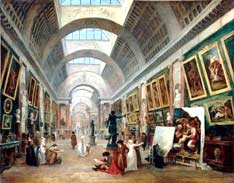
Projet d'aménagement de la Grande
Galerie du Louvre, vers 1789?
by Hubert Robert, 1796
Musée du Louvre |
|
| |
The present Louvre departments include Oriental (ancient Mesopotamian) antiquities; Egyptian antiquities; Greek and Roman antiquities; sculpture from the Middle Ages to modern times; furniture and objets d'art; and paintings representing all the European schools. A section of the museum is devoted to Islamic art.
Universally famous ancient works of art in the Louvre include a statuette of the Sumerian ruler Gudea, a stele bearing Hammurabi's code, an Egyptian painted stone statue of a scribe sitting cross-legged, the Venus de Milo, and the Victory of Samothrace. Among outstanding later works are two marble Slaves by Michelangelo, the treasure of the abbey of St. Denis, and the French crown diamonds. Important paintings include the Pietà of Avignon, Leonardo da Vinci's Mona Lisa, Veronese's immense Wedding at Cana (which was badly damaged in 1992 while being installed in the newly renovated galleries), and Watteau's Embarkation for Cythera.
The school of the Louvre trains curators in history of art and archaeology. Special exhibits are indicated in the Revue du Louvre.
Archaeological Discoveries
Traces of the medieval fortress from which the present day palace originates have been uncovered. Restoration work on the Cour Carrée and the excavation required for construction of the pyramid and the Carrousel area enabled archeological digs to be undertaken, and for the various phases of occupation of the palace and its quarters to be seen.
The architectural structures of the basement will henceforth be included in the visit tours. Thus, it is possible to walk along the moats of the medieval fortress under the Cour Carrée, to pass around the base of the dungeon to get to the Salle Saint-Louis (13th century), or — when going to the underground carpark — to walk along the so-called Charles V Moats.
Amongst the items discovered during these digs, one of the most remarkable is a parade helmet belonging to Charles VI, which was reconstituted from the one hundred and sixty-nine fragments which were found scattered about. It is on display in the Salle Saint-Louis (Sully Wing).
Admission
For those who plan to visit many monuments and museums during your séjour à Paris, Discover France offers the "Museums and Monuments Card" (Carte Musées et Monuments), valid for unlimited visits and priority access to approximately 70 locations in — and near — Paris. It can also be purchased at the Paris Tourist Office (127, avenue des Champs-Elysées), at its reception offices in certain Paris train stations, at the Eiffel Tower, in the major Métro stations, or at most of the 70 attractions. Cards are available in denominations valid for either one, three, or five consecutive days.
http://www.discoverfrance.net/France/Paris/Museums-Paris/Louvre.shtml |
|
|
|
|
|
AMORC 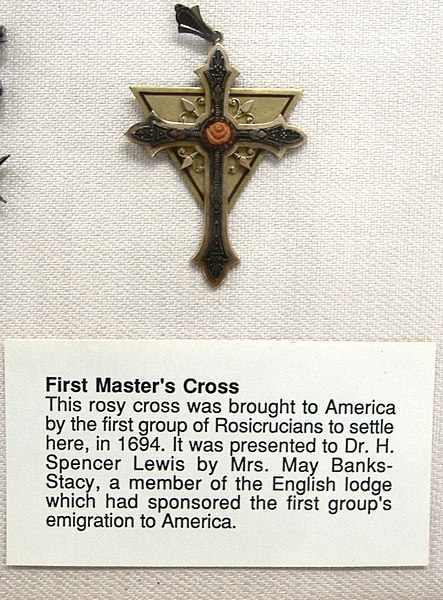 In 1909 Harvey Spencer Lewis visited France in search of Rosicrucians, was duly initiated in Toulouse, France, and given the mandate to establish an order in North America. There is a connection between the AMORC and the Martinists 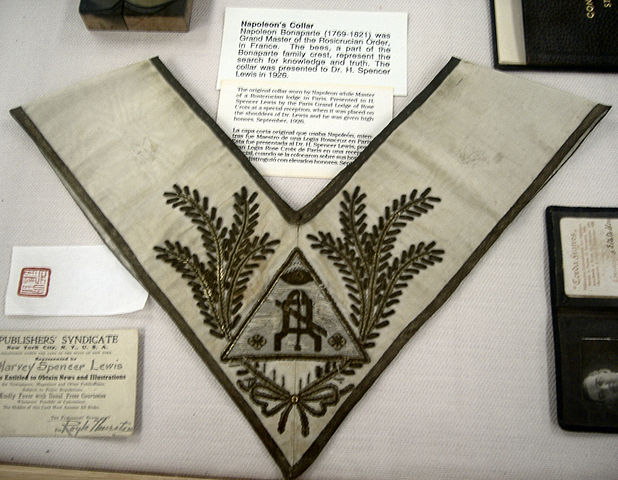 Napoleon's collar of the Roisicrucians
_________________
Everything is Connected and there are no
coincidences
|
|
|
|
|
Napoleon III 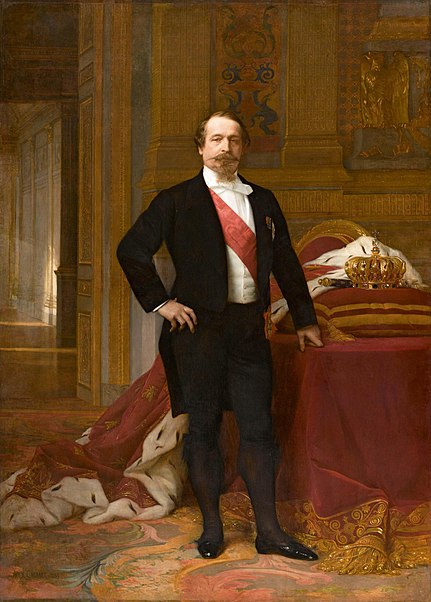 Napoleon III is seen standing, wearing haute couture instead of a military uniform: a black dinner jacket with a white shirt, black short trousers with black stockings and fitting leather shoes. This suit was fashionable at that time. His only decoration is the medal of the Legion of Honour on his left and the red sash across his right shoulder. His right hand rest comfortably on his right hip, giving an air of confidence. The only indication of his imperial status is the long red mantle with hermine and the golden imperial crown and sceptre resting on the table, on which Napoleon III is resting his left hand on. The gilded room is presumable one of the Tuileries Palace. The bee is on the red mantle and the bee is on his Imperial standard and Grand Armes 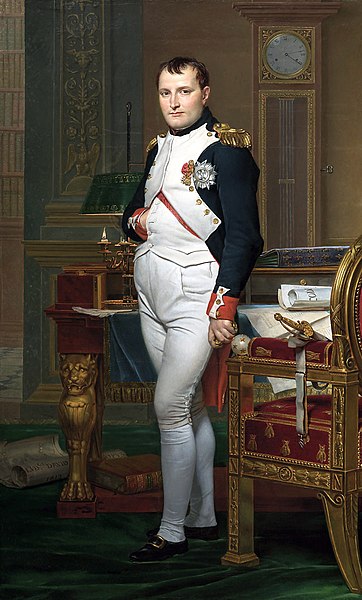 The Merovingian Bee ....found in Childeric grave symbol for Napoleon dynasty This is a list of people who, according to AMORC, were Rosicrucians or associated with Rosicrucian Tradition and work. A ceremonial collar belonging to Napoleon Bonaparte, Emperor of the French while serving as Master of a Rosicrucian Order jurisdiction based in Paris. Isaac Newton Leonardo da Vinci Heinrich Cornelius Agrippa Dante René Descartes Blaise Pascal Gottfried Leibnitz Christopher Wren Benjamin Franklin Thomas Jefferson Michael Faraday Claude Debussy Erik Satie Edith Piaf Napoleon Bonaparte Francis Bacon 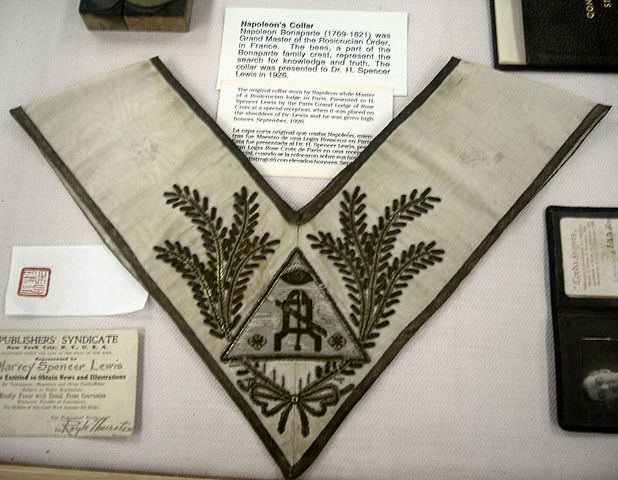 Napoleon collar Aachen Cathedral has the triangle with the all seeing eye ...Aachen was a major cathedral for Charlemagne The church is the oldest cathedral in northern Europe and was known as the "Royal Church of St. Mary at Aachen" during the Middle Ages. For 600 years, from 936 to 1531, the Aachen chapel was the church of coronation for 30 German kings and 12 queens. There had always been a royal court at Aachen under the Merovingians but it came in greater importance under Charlemagne In the summer of 1804, Empress Josephine went to Aix-la-Chapelle (Aachen) to take the waters there, and during her stay, on August 1, she visited the tomb of Charlemagne in the Cathedral. We are told that Napoleon, who joined Josephine at Aix-le-Chapelle on September 3, had already authorized the Cathedral chapter to part with certain of the relics and bestow them upon Josephine at the time of her visit to the tomb. This authorization, of course, was only a polite equivalent for a command, and was duly carried out, the most prized object secured by Josephine being precisely this famed talisman. It eventually came into the hands of Hortense, Josephine's daughter, the mother of Napoleon III, and was inherited by him. It is said to be now in a private collection in Paris. Empress Eugenie is stated to have worn it at the time of the birth of the Prince Imperial, and to have further shown her belief in the mystic, or magic, virtues of the talisman by sending it several years later to Biarritz, that it might be kept for a time in the sick-room of M. Bacciochi, when he was prostrated by illness in that city. http://www.jjkent.com/articles/ancient- ... powers.htmIt seems that Wiki Leaks a group headed by Assange released the information on the AMORC and Roisicrucians in 2007 a US based Rosicrucian order: "Liber 777 - The Celestial Sanctum", "Liber 888 - Council of Solace" and the "Silent Council Card". Assange live protected at the Embassy of Ecuador and is under arrest in England for aiding A soldier name Manning who is being tried for leaking Information from the US government The Wiki leaks material on the AMORC is very ILLUMINATING 
_________________
Everything is Connected and there are no
coincidences
|
|
|
|
|
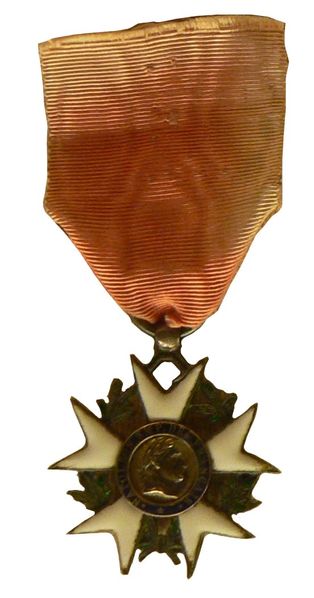 1804 Napoleon Legion of honour French Legion of Honour, knight insigna, Ist Empire, by order of 1804  newer version 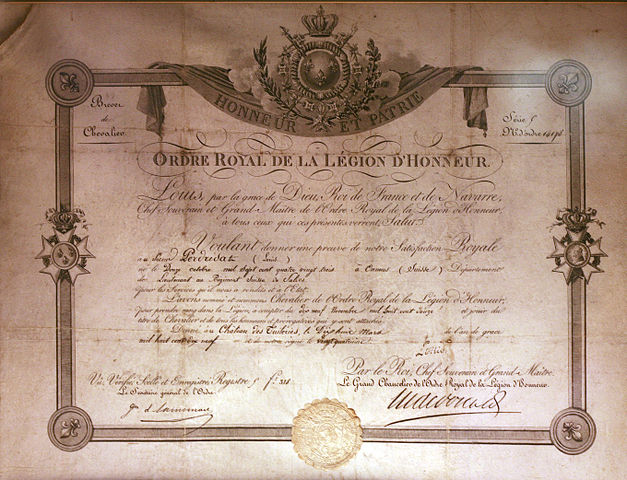 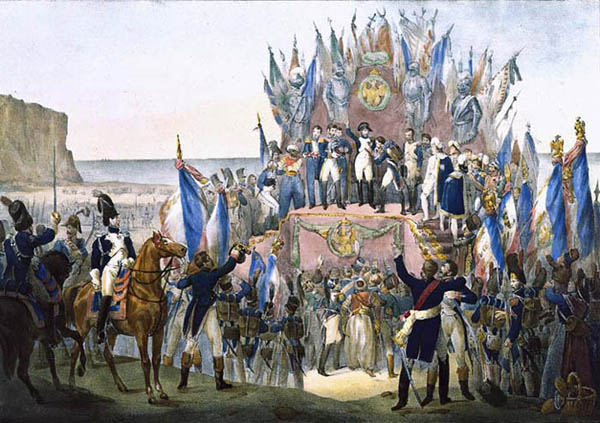
_________________
Everything is Connected and there are no
coincidences
|
|
|
|
|
L'Église de la Madeleine, L'Église Sainte-Marie-Madeleine, or simply La Madeleine, is a church dedicated to St. Mary Magdalene in Paris. It was designed as a classical temple to the glory of Napoleon's army. n 1806 Napoleon made his decision, commissioning Pierre-Alexandre Barthélémy Vignon to build a Temple de la Gloire de la Grande Armée (Temple to the Glory of the Great Army) based on the design of an antique temple. The existing foundations were again razed and work began anew. With completion of the Arc de Triomphe in 1808, the original commemorative role for the temple was blunted. After the fall of Napoleon, with the Catholic reaction during the Restoration, King Louis XVIII determined that the structure would be used as a church. Vignon died in 1828 before completing the project and was replaced by Jacques-Marie Huvé. In 1837 it was briefly suggested that the building might best be utilized as a train station, but the building was finally consecrated as a church in 1842. Today, the Madeleine is affiliated with a Benedictine abbey. http://www.insecula.com/salle/photo_ME0000061130.html
_________________
Everything is Connected and there are no
coincidences
|
|
|
|
|
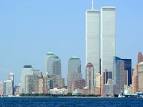
drjudywood.com
The WTC twin towers towering
800 × 600 - 84k - jpg |

en.wikipedia.org
to the World Trade Center,
4256 × 3426 - 12407k - jpg |
|
|
7. Génesis 49:17 Será Dan SERPIENTE junto al camino, Víbora junto a la senda, Que muerde los talones del caballo, Y hace caer hacia atrás al jinete.
|
|
|
Apocalipsis 9
1. El quinto ángel tocó la trompeta, y vi una estrella que cayó del cielo a la tierra; y se le dio la llave del pozo del abismo.
2. Y abrió el pozo del abismo, y subió humo del pozo como humo de un gran horno; y se oscureció el sol y el aire por el humo del pozo.
3. Y del humo salieron langostas sobre la tierra; y se les dio poder, como tienen poder los escorpiones de la tierra. (EL ESCORPION ES LA FLEUR DE LIS DEL CODIGO DA VINCI)
4. Y se les mandó que no dañasen a la hierba de la tierra, ni a cosa verde alguna, ni a ningún árbol, sino solamente a los hombres que no tuviesen el sello de Dios en sus frentes.
8. Apocalipsis 13:16 Y hacía que a todos, pequeños y grandes, ricos y pobres, libres y esclavos, se les pusiese una MARCA en la mano derecha, o en la frente;
9. Apocalipsis 13:17 y que ninguno pudiese comprar ni vender, sino el que tuviese la MARCA o el nombre de la bestia, o el número de su nombre.
10. Apocalipsis 14:9 Y el tercer ángel los siguió, diciendo a gran voz: Si alguno adora a la bestia y a su imagen, y recibe la MARCA en su frente o en su mano,
11. Apocalipsis 14:11 y el humo de su tormento sube por los siglos de los siglos. Y no tienen reposo de día ni de noche los que adoran a la bestia y a su imagen, ni nadie que reciba la MARCA de su nombre.
12. Apocalipsis 15:2 Vi también como un mar de vidrio mezclado con fuego; y a los que habían alcanzado la victoria sobre la bestia y su imagen, y su MARCA y el número de su nombre, en pie sobre el mar de vidrio, con las arpas de Dios.
13. Apocalipsis 16:2 Fue el primero, y derramó su copa sobre la tierra, y vino una úlcera maligna y pestilente sobre los hombres que tenían la MARCA de la bestia, y que adoraban su imagen.
14. Apocalipsis 19:20 Y la bestia fue apresada, y con ella el falso profeta que había hecho delante de ella las señales con las cuales había engañado a los que recibieron la MARCA de la bestia, y habían adorado su imagen. Estos dos fueron lanzados vivos dentro de un lago de fuego que arde con azufre.
15. Apocalipsis 20:4 Y vi tronos, y se sentaron sobre ellos los que recibieron facultad de juzgar; y vi las almas de los decapitados por causa del testimonio de Jesús y por la palabra de Dios, los que no habían adorado a la bestia ni a su imagen, y que no recibieron la MARCA en sus frentes ni en sus manos; y vivieron y reinaron con Cristo mil años.
5. Y les fue dado, no que los matasen, sino que los atormentasen cinco meses; y su tormento era como tormento de escorpión cuando hiere al hombre.
6. Y en aquellos días los hombres buscarán la muerte, pero no la hallarán; y ansiarán morir, pero la muerte huirá de ellos.
7. El aspecto de las langostas era semejante a caballos preparados para la guerra; en las cabezas tenían como coronas de oro; sus caras eran como caras humanas;
8. tenían cabello como cabello de mujer; sus dientes eran como de leones;
9. tenían corazas como corazas de hierro; el ruido de sus alas era como el estruendo de muchos carros de caballos corriendo a la batalla;
10. tenían colas como de escorpiones, y también aguijones; y en sus colas tenían poder para dañar a los hombres durante cinco meses.
11. Y tienen por rey sobre ellos al ángel del abismo, cuyo nombre en hebreo es Abadón, y en griego, Apolión.
|
|
|
|
|
Napoleón Bonaparte
Militar
Napoleón I Bonaparte fue un militar y gobernante francés, general republicano durante la Revolución y el Directorio, artífice del golpe de Estado del 18 de brumario que lo convirtió en primer cónsul de la ... Wikipedia
|
|
NACIDO EL 15 DE AGOSTO, EL DIA DE LA ASUNCION DE LA VIRGEN, 227 GREGORIANO.
¿CASUALIDAD O CAUSALIDAD?
NAPOLEON / APOLO (CONSTELACION DE LEO) / LEON
EVERYTHING IS CONNECTED AND THERE ARE NO COINCIDENCES
|
|
|
|
|
|
|
|
https://books.google.com.ar/books?isbn=8476002955
El 7 de septiembre, el destino de Napoleón, el de su Imperio y el de los pueblos de Europa se unieron en las riberas del Kolotcha. ... Después de Borodino había sido publicado un anuncio en Les Nouvelles de Moscou: "El viernes 30 de agosto (es decir, el 11 de septiembre) los actores imperiales rusos presentaron ...
|
|
|
 Primer Primer
 Anterior
12 a 26 de 71
Siguiente Anterior
12 a 26 de 71
Siguiente Último
Último
|
|
| |
|
|
©2025 - Gabitos - Todos los derechos reservados | |
|
|

